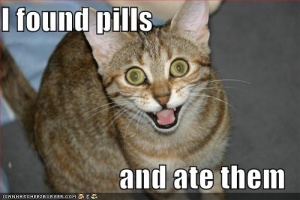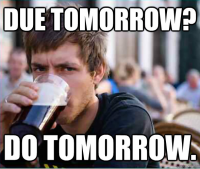Difference between revisions of "Internet meme"
| Line 9: | Line 9: | ||
| − | '''Internet Memes''' are concepts that spread throughout the internet. They are user generated concepts, ideas, behaviors or styles that propagate throughout internet culture. They can take the form of hyperlinks, pictures, websites, words, videos or sayings. They usually convey sarcastic or ironic phrases. Internet memes are spread across the internet through sharing. Once a meme is a created it is submitted or uploaded to somewhere such as [[4chan]], [[Reddit]], [[Facebook]] or any other media websites. The spread continues through continuous sharing. | + | '''Internet Memes''' are concepts that spread virally throughout the internet. They are user generated concepts, ideas, behaviors or styles that propagate throughout internet culture. They can take the form of hyperlinks, pictures, websites, words, videos or sayings. They usually convey sarcastic or ironic phrases. Internet memes are spread across the internet through sharing. Once a meme is a created it is submitted or uploaded to somewhere such as [[4chan]], [[Reddit]], [[Facebook]] or any other media websites. The spread continues through continuous sharing. |
==Origins of the Word== | ==Origins of the Word== | ||
Revision as of 21:21, 6 December 2012
Internet Memes are concepts that spread virally throughout the internet. They are user generated concepts, ideas, behaviors or styles that propagate throughout internet culture. They can take the form of hyperlinks, pictures, websites, words, videos or sayings. They usually convey sarcastic or ironic phrases. Internet memes are spread across the internet through sharing. Once a meme is a created it is submitted or uploaded to somewhere such as 4chan, Reddit, Facebook or any other media websites. The spread continues through continuous sharing.
Contents
Origins of the Word
Richard Dawkins first introduced the concept of a meme in his book "The Selfish Gene." Forging a conception of ideas as objects which are transmitted and replicated through sociality much in the way genes are transmitted and replicated through sexual reproduction, he defines a meme in his book as follows:
"Examples of memes are tunes, ideas, catch-phrases, clothes fashions, ways of making pots or of building arches. Just as genes propagate themselves in the gene pool by leaping from body to body via sperms or eggs, so memes propagate themselves in the meme pool by leaping from brain to brain via a process which, in the broad sense, can be called imitation. If a scientist hears, or reads about, a good idea, he passed it on to his colleagues and students. He mentions it in his articles and his lectures. If the idea catches on, it can be said to propagate itself, spreading from brain to brain. As my colleague N.K. Humphrey neatly summed up an earlier draft of this chapter: `... memes should be regarded as living structures, not just metaphorically but technically.(3) When you plant a fertile meme in my mind you literally parasitize my brain, turning it into a vehicle for the meme's propagation in just the way that a virus may parasitize the genetic mechanism of a host cell. And this isn't just a way of talking -- the meme for, say, "belief in life after death" is actually realized physically, millions of times over, as a structure in the nervous systems of individual men the world over[1]."
Analysis
Connection to Dawkins' Theory
The replication and development of the internet meme begins far before it is even created in and of itself. Stemming from the meme that frames this type of internet meme as a standard picture with one line of expository text and one punchline, the nature of which is adherent to a consistent theme for all memes using the picture, the LCS meme is sort of a "submeme." The overall format has replicated and spread through human transmission taking on many iterations, one of which is the LCS. This example gives a cursory (and lighthearted) example of Dawkins' theory.
Internet Memes in the real world
Some internet memes grow so popular, they can be encountered offline. A fairly popular example of an internet meme leaving The Web is the phrase, "OMG!". OMG began as an abbreviation for "Oh, my God!" or "Oh, my Goodness!" found in online comments and informal emails. However, the phrase "OMG" is heard spoken in everyday speech.
Conversely, PostSecret, a community mail art project turned internet phenomenon, began offline and made its way online. Users post secrets anonymously on an artistic postcard in an effort to rid themselves of the strain of keeping this secret to themselves. It began as a mail campain but is now a popular weblog (or blog).[2]
Creation
At the onset of memes, many of them were simply sayings or jokes that became popular to use as comments on blogs or other sites such as YouTube, Reddit, and Tumblr. Nowadays, most memes are photos with text overlaid onto the image to create a specific tone and message that relates to others or is catchy enough to become popular (as shown here).
Many websites have since been created to service those who want to create their own memes. One popular website is QuickMeme [3]. On this site, users can choose from the vast array of memes that have already been created and choose their own saying to overlay, or they can even upload their own photo and make an entirely new meme from scratch. On the main page of the website, users can also scroll through millions of memes that have been created just for the fun of reading them all.
Websites such as QuickMeme <rem name = "quickmeme"/> have voting systems that allow users to choose which ones they enjoy the most. Users can then filter out "good" memes opposed to "bad" memes based on their scores and popularity.
Examples
Lolcats

A lolcat is a popular form of internet meme, believed to have been started by users on 4chan. A lolcat depicts a cat and a humorous tagline. Hence, the name lolcat is a combination of 'lol' reflecting the humor aspect of the meme and 'cat' reflecting the image content. There are two common forms of lolcats:
- 1. An image of a cat bordered in black with a short tagline beneath the image.
- 2. An image of a cat with a short tagline at the top, bottom, or top and bottom of the image.
The cat images frequently display a cat in an peculiar position or with a funny expression. Similar memes have been created without a cat as the main focus and are referred to as 'lols'.
Ethical Concerns
Control
One ethical concern of the Internet meme is the lack of controlling its spread throughout cyberspace. Controlling the spread of a meme is virtually impossible once it takes off. Combine this with the fact that many memes are hilarious precisely because of the earnestness of their original images, and ethical problems can result. [5] There are things that we can control on the internet. However, after a meme is released on the web it seems impossible to control the spread of it, which can be detrimental when offensive memes are posted, and later regretted and cannot be taken down from everywhere on the internet.
Offensiveness
A big part of the Internet’s beauty is the freedom to share, reinterpret and reimagine content, and stifling this feature would make the Internet a very different place. At the same time, who wants to make a person they’ve never met feel terrible?[6] As often memes can be offensive to certain groups of people, another ethical concern of internet memes is their target audiences and how they may be perceived by different groups of people (some of which may think the memes are highly offensive).
One solution to this would be "a similar directive in web code could be developed to let content creators say that they’d prefer not to become a meme". [7] This would protect people’s privacy without changing the participatory “remix” culture of the Internet, or forcing content creators to resort to lawsuits to protect themselves. [8]
Recycling content
Should we care?
People usually recycle memes by making edits to current ones. For instance, sometimes the same image is used with new captions. The question that arises is: who owns the meme? Do we have the right to reproduce images and recycle memes? It may qualify as an instance of plagiarism if someone decides to take ownership and prevent others from replicating a meme.
Posting advertisements
Some platforms like QuickMeme <rem name = "quickmeme"/> allow people to post advertisements between a cluster of memes. These advertisements usually take the form of thumbnails of the same size and dimension as the meme. Some people argue that this is a forceful form of advertisement where the user is forced to look at an ad, often without his/her approval. Usually advertisements appear in corners of the screen, where it does not interfere with the user's activity and he/she always has the choice of viewing them or ignoring them. But, in this case there is no choice to ignore an advertisement as it appears within the cluster of memes on a page and one may accidentally click on such advertisements.
References
- ↑ http://www.rubinghscience.org/memetics/dawkinsmemes.html
- ↑ Post Secret. Wikipedia. Retrieved 2011-12-11.
- ↑ http://www.quickmeme.com
- ↑ http://s1.static.gotsmile.net/images/2011/10/19/lolcat-funny-picture-found-pills-ate-eat_131902699269.jpg
- ↑ http://careermash.ca/blogs/memes-and-ethics-new-participatory-web
- ↑ http://careermash.ca/blogs/memes-and-ethics-new-participatory-web
- ↑ http://careermash.ca/blogs/memes-and-ethics-new-participatory-web
- ↑ http://careermash.ca/blogs/memes-and-ethics-new-participatory-web
